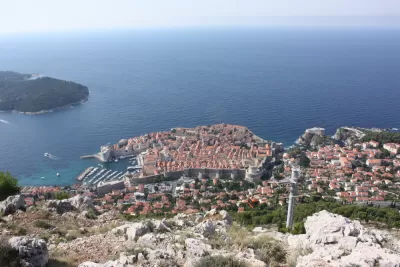Spoilers are coming.

Feargus O'Sullivan chimes in on the big question of the day: What are we to think of the fate of King's Landing?
Social media channels has been overwhelmed this week with discussion about the events in the penultimate episode of Game of Thrones, aired last week, ahead of the finale episode tonight, so it's only fair that someone finally found an urbanism angle to report.
O'Sullivan writes:
In the midst of the recent hullaballoo about “The Bells,” the penultimate episode of HBO’s Game of Thrones, something got missed in the confusion. The true star of the episode was neither a newly unsympathetic Daenerys nor her fire-breathing baby. The real focus was the city of King’s Landing itself, shown up close and in remarkable detail just at the moment when it, and its unlucky residents, were being scorched to smithereens.
According to O'Sullivan, The Bells presented Kings Landing with new detail, showing the city's "true extent" for the first time. What we see is a beautiful city, with reasonable comparisons to Dubrovnik, Valletta, Malta, Girona, and Istanbul. The effect is a "Pre-Ottoman Constantinople," according to Feargus.
All of those comparisons are familiar, however. The world learned in The Bells that Kings Landing might better described like Denmark in Shakespeare's Hamlet.
…King’s Landing may be impressive to look at, but it’s largely a miserable place to live in, and the world that created it is rotten.
This is a civilization that can construct buildings so impressive that they make soaring real-life medieval cathedrals look like shrubs in comparison. The streets beneath the citadels, however, are largely mean, dingy warrens so tightly packed with people that a jumping flea could travel the city’s circumference without ever leaving a body. In “The Bells,” incinerated spires crash from the sky and onto the terrified folk below—death by authoritarian architecture. Faced with a dragon, not even the city walls are much use to the people shown desperately trying to press through their gates to what they think is safety.
Such dichotomous realities are familiar in the real world, notes O'Sullivan, including some of the cities listed above.
FULL STORY: King’s Landing Was Always a Miserable Dump

Planetizen Federal Action Tracker
A weekly monitor of how Trump’s orders and actions are impacting planners and planning in America.

San Francisco's School District Spent $105M To Build Affordable Housing for Teachers — And That's Just the Beginning
SFUSD joins a growing list of school districts using their land holdings to address housing affordability challenges faced by their own employees.

Can We Please Give Communities the Design They Deserve?
Often an afterthought, graphic design impacts everything from how we navigate a city to how we feel about it. One designer argues: the people deserve better.

Engineers Gave America's Roads an Almost Failing Grade — Why Aren't We Fixing Them?
With over a trillion dollars spent on roads that are still falling apart, advocates propose a new “fix it first” framework.

The European Cities That Love E-Scooters — And Those That Don’t
Where they're working, where they're banned, and where they're just as annoying the tourists that use them.

Map: Where Senate Republicans Want to Sell Your Public Lands
For public land advocates, the Senate Republicans’ proposal to sell millions of acres of public land in the West is “the biggest fight of their careers.”
Urban Design for Planners 1: Software Tools
This six-course series explores essential urban design concepts using open source software and equips planners with the tools they need to participate fully in the urban design process.
Planning for Universal Design
Learn the tools for implementing Universal Design in planning regulations.
Borough of Carlisle
Smith Gee Studio
City of Camden Redevelopment Agency
City of Astoria
Transportation Research & Education Center (TREC) at Portland State University
City of Camden Redevelopment Agency
Municipality of Princeton (NJ)



























